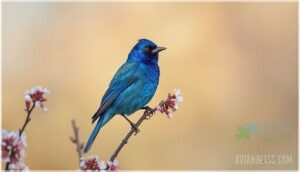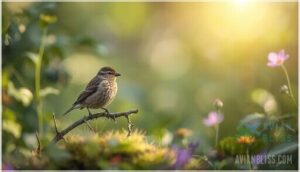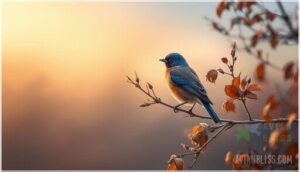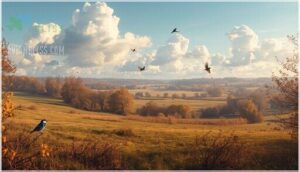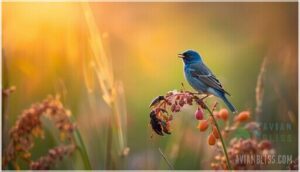This site is supported by our readers. We may earn a commission, at no cost to you, if you purchase through links.

These small birds know how to make themselves scarce, yet their migrations mark the seasons more reliably than any calendar. If you’ve ever wondered how a songbird’s journey crosses a continent, or what secrets hide behind that electric blue, you’re about to find out.
Table Of Contents
- Key Takeaways
- Indigo Bunting Identification and Appearance
- Indigo Bunting Habitat and Geographic Range
- Indigo Bunting Migration Patterns
- Indigo Bunting Diet and Foraging Behavior
- Indigo Bunting Breeding and Nesting Habits
- Frequently Asked Questions (FAQs)
- What is indigo bunting?
- Where does the indigo bunting live?
- What kind of bird is an indigo bunting?
- Do indigo buntings have blue plumage?
- How do you find an indigo bunting?
- Do indigo buntings sing?
- Why are indigo buntings important?
- Where do indigo buntings live?
- What does an indigo bunting look like?
- Are indigo bunting a good bird?
- Conclusion
Key Takeaways
- Indigo Bunting males show brilliant blue feathers due to feather structure, while females and juveniles blend in with brown plumage for camouflage.
- These birds thrive at the edges where open fields meet brush or woodland, shifting habitats between breeding in North America and wintering in Central America or the Caribbean.
- Indigo Buntings migrate at night using the stars and geomagnetic cues, with their journeys marked by long flights across the Gulf and seasonal flocking in winter.
- Their diet changes with the seasons, favoring insects in summer and switching to seeds and berries in fall and winter to fuel migration and survival.
Indigo Bunting Identification and Appearance
Spotting an Indigo Bunting can be a thrill, but telling them apart takes a sharp eye. Their looks shift with season, age, and even how close you manage to get. Let’s break down what sets them apart, one feature at a time.
Male Plumage Characteristics
Blue coloration on a male Indigo Bunting is no illusion. Feather structure, not pigment, creates those vivid blues. Every spring, through molt patterns and iridescence effects, the breeding plumage practically shouts for attention, ranging from deep blues on the head to lighter shades on the body.
If you’re seeking Indigo Bunting identification, note this bold plumage variation among male characteristics. Understanding the bird’s wing molt patterns is vital for identifying age and sex differences.
Female and Juvenile Coloration
Color patterns truly set the Female Indigo Bunting apart. Unlike the vibrant males, you’ll notice females and juveniles wear brown plumage flecked with faint streaks—prime camouflage strategies. Molt cycles don’t bring much change; their feather structure stays simple, blue almost never appears.
For Indigo Bunting identification, that understated bird plumage makes all the difference compared to flashier males. Understanding the bird’s natural habitat preferences is also essential for effective observation.
Seasonal Plumage Changes
Once you’ve spotted the female’s understated look, you’ll notice how Indigo Buntings play with Plumage Coloration as the seasons shift. Males trade bright breeding plumage for duller winter plumage each fall.
Hormonal Regulation drives Feather Molting, blending blues with browns—blotchy patches serve as camouflage strategies between breeding displays and migration, until fresh color returns in spring.
Size and Body Structure
Keep an eye out for the Indigo Bunting’s compact, stocky build—its body length averages 12–13 centimeters, with a short, rounded tail that keeps it agile in brushy terrain. Thick, conical beak shape is made for cracking seeds. Their wingspan runs roughly 19–22 centimeters. Legs are sturdy and adapted for grasping, key to this bird’s shape and movement.
Comparison to Similar Bird Species
When you’re knee-deep in the field, Species Differentiation matters most. Indigo Bunting identification hinges on Plumage Comparison: blue all over, unlike the multi-colored Lazuli Bunting or chestnut-tinged Blue Grosbeak.
Similar bird species like these share habitats, yet beak structure, subtle size differences, and unique Song Patterns set them apart within the Cardinalidae family. Details make the bird.
Indigo Bunting Habitat and Geographic Range
If you’ve ever wondered where the indigo bunting feels at home, you’re not alone. These birds follow the open spaces and edges that offer both shelter and freedom.
Let’s take a look at the landscapes and regions that make up their world.
Preferred Habitats and Environments
If you want to spot an Indigo Bunting, follow the edge where wild meets tidy. Habitat selection hinges on boundary zones—where fields blend with trees or brushy pastures. Here’s what they look for:
- Dense shrubland ecology
- Open fields thick with weedy cover
- High song perches
- Mixed vegetation density
- Ecotone preferences shaped by edge effects
Breeding and Wintering Locations
Every Indigo Bunting follows an ancient script—Breeding Grounds stretch from southern Canada to Texas, filling brushy margins and field edges with song and territorial behavior.
As crisp leaves fall, they chart long Migration Routes to Wintering Sites in the Caribbean, Central America, and southern Florida. Habitat selection shifts with the season, and blue feathers vanish into green canefields and tangled citrus groves.
Regional Distribution in North America
Picture a map flecked with blue—Indigo Bunting breeding grounds sprawl from southern Canada through Texas, making them a familiar voice in much of eastern North America.
Their range grows thinner in the west, where population trends dip. Habitat fragmentation shapes these bird migration patterns, yet the indigo bunting remains a bold traveler across the continent’s patchwork of regions.
Indigo Bunting Migration Patterns
Understanding how Indigo Buntings migrate can reveal a few surprises about where and how they travel. These birds don’t stick to one spot—they follow ancient paths shaped by instinct and the pull of the seasons.
Let’s lay out the main patterns that guide their journey each year.
Spring and Fall Migration Routes
Watch the sky in spring, and you’ll see bold migration patterns unfold as Indigo Buntings stream north. Their flight routes cross the Gulf in one push, conquer inland corridors, or hug the coast.
Here’s the journey, broken down:
- Massive Gulf crossing of nearly 900 kilometers
- Peak spring arrivals in the Midwest, Mississippi Flyway
- Essential stopover sites along southern coasts
Nocturnal Navigation and Adaptations
Think a compass is enough for Indigo Bunting migration? Think again. After sunset, your stars are their maps. Indigo Buntings chart their journey by Celestial Orientation, weaving migration patterns under darkness.
Their brains pair Geomagnetic Sensing with Bird navigation, tuning circadian rhythms for Nocturnal Restlessness. The result: each bunting rides the hidden highways of the night, guided by cosmic cues.
Wintering Grounds and Seasonal Behavior
Under the bright stars, Indigo Buntings finally settle in winter habitats across Central America, the Caribbean, and southern reaches of the U.S. You’ll see them sporting a patchwork of winter plumage as they flock together, trading bold solos for community life.
Their shift in diet—seeds and berries—echoes smart dietary adaptations.
Conservation efforts matter, as winter habitat loss patterns impact Indigo Bunting migration.
Indigo Bunting Diet and Foraging Behavior
Curious what Indigo Buntings eat through the seasons? Their food choices shift with the landscape and time of year.
Here’s what you need to know about how they find their next meal.
Seasonal Dietary Shifts
Change drives every Indigo Bunting diet. You notice sharp transitions—summer belongs to Insect Consumption, fueling energy and breeding. Come fall, Seed Preferences rule, helping birds gain reserves for migration. In winter, Dietary Adaptations mean survival relies on seeds and berries. Spring awakens renewed Foraging Strategies as nutrition shifts, all tuned to the quest for efficient Nutrient Acquisition.
- Insect Consumption dominates the breeding season.
- Seeds become essential in autumn and winter.
- Foraging Strategies shift as resources fade or return.
- Nutrient Acquisition mirrors each season’s demands.
Preferred Food Sources
When you look at the Indigo Bunting diet, you see a clear rhythm set by need and opportunity. Seed Preferences lead the way much of the year, and Insect Consumption surges during breeding. Berry Eating rises when sugar matters most, but never outweighs seeds or insects.
Dietary Adaptations reveal a bird built for shifting fortunes, always tuned to changing food.
Foraging Techniques and Feeding Habits
Foraging is rarely a static affair. Indigo Buntings master ground foraging for seed consumption when winter bites, then leap into shrubs for insect capture as summer arrives.
Sometimes they’ll join flocks to gather food faster, reducing fights over scraps. Single birds and groups alike blend berry eating and seed diet, showing just how variable Indigo Bunting feeding habits can be.
Indigo Bunting Breeding and Nesting Habits
If you want to really understand Indigo Buntings, it helps to know how they breed and raise their young. There’s a pattern to how they find a mate, build a nest, and care for their chicks.
Here’s what you’ll see if you look close during their nesting season.
Mating Rituals and Territoriality
Mate Selection among breeding male Indigo Buntings is no staged affair—it’s a bold dance on the edge of defiance. You watch these birds flex their Breeding Strategies through Courtship Displays and Song Patterns that mark every inch of turf. Here’s how Territorial Defense and breeding behavior play out:
- Monogamous bonds—sometimes just for a season
- Fierce territory lines
- Males sing unique, complex songs
- Visual strutting displays
- Rivals met by aggression, not retreat
Nest Construction and Placement
Nest Architecture in Indigo Buntings is deliberate. Your eyes might spot nests woven low within thorny shrubs, favoring branch stability over height.
Site Selection depends on dense vegetation; camouflaged cups are crafted with grasses, leaves, and spider web.
Material Gathering showcases resourcefulness, while Nest Camouflage keeps predators guessing.
Nest building is solitary—females handle every intricate detail of Indigo Bunting Nesting.
Egg Laying and Chick Rearing
Egg Incubation in Indigo Buntings takes 11 to 14 days, with the female tending the eggs in low, woven nests. After hatching, young birds rely on the mother for feeding and warmth.
Chick Development progresses as insects dominate the early diet. Nesting Success and Brood Survival depend on steady Feeding Behavior, leading to strong Fledging Rates each season.
Frequently Asked Questions (FAQs)
What is indigo bunting?
You might find the Indigo Bunting—a bird species known as Passerina cyanea—alone on a fence line, its feather structure catching the light in ways that make color variation almost magical.
Its migration patterns and bold appearance draw bird identification enthusiasts every year.
Where does the indigo bunting live?
You’ll find Indigo Buntings in brushy forest edges, shrubby fields, and woodland margins. Their range stretches across eastern North America.
They breed in open, weedy habitats and migrate at night to wintering areas in Central America and southern Florida.
What kind of bird is an indigo bunting?
Think of this bird as a shimmery blue jewel cutting across summer fields.
An Indigo Bunting belongs to the songbird group, famous for intricate feather structure, sharp beak function, and bold song patterns guiding its winding migration routes.
Do indigo buntings have blue plumage?
Vibrant blue plumage isn’t just a show; it’s a clever use of Blue Feather Structure. Indigo bunting males light up with bold colors during mating displays, while females stick with brown for Bird Camouflage and survival.
How do you find an indigo bunting?
Look for Indigo Bunting Habitat along brushy field edges and weedy clearings in their range, especially during spring Bunting Migration Patterns.
Listen for Indigo Bunting Calls and use a Bird Identification Guide for accurate Feather Identification and bird watching tips.
Do indigo buntings sing?
At dawn, a single melody ripples through fields: the male’s indigo bunting song.
These birds are tireless vocalists, weaving complex singing patterns and melodic structures. Their vocalizations drive both bird song and communication, shaping bonds and staking territory boldly.
Why are indigo buntings important?
You can spot Indigo Buntings working behind the scenes in nature. They control insects, spread seeds, and reveal changes in bird habitat.
This small avian species weaves together ecological significance, ecosystem services, and ongoing conservation status.
Where do indigo buntings live?
You’ll find these birds weaving through their Indigo Bunting habitat—edge of brush, weedy fields, open woodlands—spanning a wide geographic distribution.
Their range and migration routes stretch from Southern Canada’s breeding grounds to tropical wintering areas in Central America.
What does an indigo bunting look like?
The Indigo Bunting’s appearance is all about bold contrast. Males flash bright blue feathers in spring, while females display brown tones.
Both sexes share distinct physical traits: a short, thick beak and small, compact body proportions. These features enable quick visual identification and help in understanding plumage variation.
Are indigo bunting a good bird?
A good bird is one that fills its ecological role, aids Bird Conservation, and sparks curiosity in Bird Watching. That describes the Indigo Bunting.
Not just its vibrant Feather Care or Song Patterns, but its resilience and essential presence.
Conclusion
Picture the indigo bunting as a living shard of summer sky—a tiny burst of color worth chasing to the world’s edge. If you stare hard enough, you might spot their impossible blue slipping between shadows, rendering the ordinary wild remarkable.
The honesty of their travels, the subtlety of their survival, puts human boldness to shame. Learn from their passage: trust the dark, follow your path, and let your true colors blaze only when the light is right.
- https://animaldiversity.org/accounts/Passerina_cyanea/
- https://mnbirdatlas.org/species/indigo-bunting/
- https://www.massaudubon.org/our-work/birds-wildlife/bird-conservation-research/breeding-bird-atlases/find-a-bird?id=5944
- https://abcbirds.org/bird/indigo-bunting/
- https://txtbba.tamu.edu/species-accounts/indigo-bunting/

